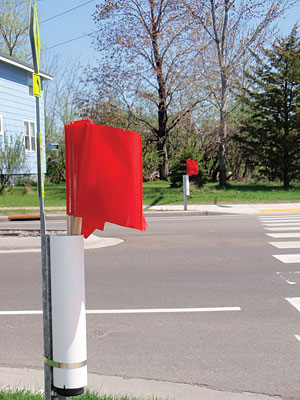A Change Will Do Us Good
the city-approved plan to better the streets for bikes, pedestrians

Invite a bunch of bikers to advise the city council and you’re going to see some lasting results. While BPAC – the Bike and Pedestrian Advisory Commission – is an official administrative limb of the city, it’s comprised of people whose end-goal is simply to get to work on two wheels.
In 2005, the city declared a need to draft a comprehensive plan for street and sidewalk redesign. Now, after a long discussion bolstered by input from the previously underrepresented bikers and walkers, the council has approved of the plan in its entirety – but they had to start from scratch.
Bob Eierman, who joined BPAC at the beginning of 2008 and now serves as commission president, says the first step was to understand the existing “condition.” Nobody had ever mapped out the city’s sidewalks before. So they did. Interrupted sidewalks could then be addressed for repair.
Next, Eierman and friends sat down and pored over those maps, thinking like the cyclists they are. Focusing on easy east-west and north-south movement, commissioners picked roads with minimal traffic to lower impact on car movement as well as improve biker safety. Popular destinations within the city also make an appearance on the routes.
Intersections necessitated slow examination, and, in some cases, red-lighted the discussion. “We just circled those 22 intersections with a big yellow marker,” says Eierman of the problem areas, noting that it’ll take more time and energy to come up with optimum plans. For the rest of the city, BPAC hashed out pros and cons until they reached a solution. Some will merely receive more signage. Others will be fundamentally changed.
One feature that Eau Claire seems fond of is the “slip lane” – the protected right turn-lane. “Slip lanes basically mean death to pedestrians,” says Eierman, only half-joking. An example of this occurs at the bottom of Harding Hill by Just Local Food, which was designed years ago for unimpeded vehicular movement because Farwell Street used to be a highway connection. The plan is to transform this into a regular right-hand turn.
“These may seem like small things,” says Eierman, “but to biking commuters and pedestrians, they’re a big deal.”
Another one of the most noticeable changes for pedestrians will be the “self-advocacy” program of flag-waving that has already been proved successful in other cities. Here’s how it works: a walker grabs an orange flag on one side of the sidewalk and deposits it in the container on the other side. “It seems so stupid,” says Eierman. “But apparently it really works.” This system is already employed at the crosswalk “just past the curve” on 5th Avenue near Luther Hospital.
Though the plan’s approval is an important first step, progress will be slow. Eierman says it may take two decades before all of the recommendations come to fruition. Beyond the physical changes, which will take a while to fund and build, the attitudes toward alternative transportation will also take time to mature. “We’ve already been sworn at and swerved at,” says Eierman. He contrasts the environment here to that of Corvallis, Oregon, where he lived for several years in the 70s. “In Oregon, if you so much as put your foot on the curb, cars will come to a complete stop. Here, they accelerate,” he jokes.
Despite pockets of opposition, Eierman believes the city, its businesses, and the university are ready and waiting for these important changes.
| Introduction « PREV | NEXT » Bikes Don't Grow on Trees |


















